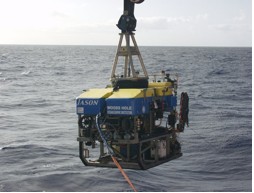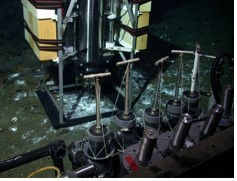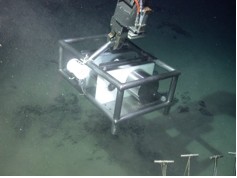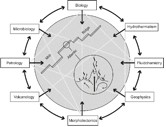Page path:
- Press Office
- Press releases 2007
- In the middle of the Atlantic Ocean: Research v...
In the middle of the Atlantic Ocean: Research vessel Maria S. Merian
On the 23rd of January the German research vessel Maria S. Merian set out with 14 scientists, 9 ROV (remote operated vehicle) crew members and 21 crew members from Fort de France, Martinique, to investigate the Logatchev hydrothermal vent field at 14°45`N, 44°58`W on the Mid-Atlantic Ridge. This cruise is part of the German Science Foundation’s Priority Program “From Mantle to Ocean” (DFG-SPP 1144) in which geologists, fluid chemists, geophysicists and biologists work together to unravel the mass and energy transfer taking place from the earth’s mantle to the ocean.
We have the ROV Jason II from the Woods Hole Oceanographic Institution on board, which we will use to recover long-term experiments left by a previous cruise with R/V Meteor, re-deploy instruments and collect various types of samples from the 3000 m deep seafloor of the hydrothermal vent field.
Jason II has never been used with a German research vessel before, and although it still seems a miracle to us that we managed to adapt this complex system based on inches, pounds and American power requirements to a metric ship, we were still able to mobilize within only 3.5 days. This could only be accomplished with the exceptional support in every respect of the ship’s crew. After successfully testing Jason II with a “harbor dip” on the morning of the 23rd January, we were ready to leave port according to schedule. During the transit to the Logatchev field, the scientists were very busy setting up their laboratories while the ROV team had the chance for additional testing of their vehicle. After 3.5 days of transit we arrived on the 26th January at the Logatchev field. The weather is good, the sea is calm, and the conditions for diving with a ROV are fine.
We have the ROV Jason II from the Woods Hole Oceanographic Institution on board, which we will use to recover long-term experiments left by a previous cruise with R/V Meteor, re-deploy instruments and collect various types of samples from the 3000 m deep seafloor of the hydrothermal vent field.
Jason II has never been used with a German research vessel before, and although it still seems a miracle to us that we managed to adapt this complex system based on inches, pounds and American power requirements to a metric ship, we were still able to mobilize within only 3.5 days. This could only be accomplished with the exceptional support in every respect of the ship’s crew. After successfully testing Jason II with a “harbor dip” on the morning of the 23rd January, we were ready to leave port according to schedule. During the transit to the Logatchev field, the scientists were very busy setting up their laboratories while the ROV team had the chance for additional testing of their vehicle. After 3.5 days of transit we arrived on the 26th January at the Logatchev field. The weather is good, the sea is calm, and the conditions for diving with a ROV are fine.
The first dive lasted 8 hours and proved successful, as hot hydrothermal fluids were measured and collected from the Irina II chimney structure, which we determined for the first time to emerge with temperatures of up to 350°C. Fluid samples collected with titanium syringes served for onboard analyses of gases (hydrogen, sulfide and methane) and other organic and inorganic compounds. The first culture experiments of the microbial communities were started. Mussels which host chemosynthetic symbionts in their gill tissues were collected in order to perform incubation experiments on board. Other macrofauna, e.g. limpets, shrimps and brittle stars will be analysed in the home laboratories.
The second dive proved equally successful as geophysical instruments were recovered after having been on the seafloor for 20 months. The ocean bottom tilt meter (OBT) and ocean bottom pressure meter (OBP) recorded local seafloor dynamics related to hydrothermal activity and tectonics. The two instruments were still in a good condition and readings of the logged data indicated that they had worked successfully for more than a year. The recovery of these data therefore marks a milestone for reaching the time-series related goals of the SPP 1144. Another major target of this dive was the “re-location” of a previously observed site with microbial mats which is located next to marker “Anya” north-west of the Irina II structure. Here we positioned an in-situ profiler that measures the horizontal gradients of environmental key parameters controlling the hydrothermal microbial communities, such as concentrations of hydrogen sulfide, hydrogen, oxygen, temperature and pH at a micro-scale. This profiler will later be used at different hydrothermal environments including mussel beds. The microbial mat was also sampled with push cores for ex-situ experiments on microbial turnover processes and for genomic analysis of the microbial population.
While Jason II dived during day time, we dedicated our first night in the research area to the detection of the hydrothermal plume in the water column by CTD casts.
An unusual incident on Sunday elucidated very clearly how small and vulnerable we are in the middle of the ocean. A German sailing boat which was only 35 nm miles apart from our position at Logatchev had a broken mast and asked for support with food, water and diesel in order to be able to continue sailing with reduced speed to their destination in the Caribbean. We interrupted our research and searched for the only 10.5 m long boat which we met around midnight. The two sailors were well and we supplied them with what they needed before they continued on their way and we took on with our work. We wish them good luck and hope that they will arrive safely!
An unusual incident on Sunday elucidated very clearly how small and vulnerable we are in the middle of the ocean. A German sailing boat which was only 35 nm miles apart from our position at Logatchev had a broken mast and asked for support with food, water and diesel in order to be able to continue sailing with reduced speed to their destination in the Caribbean. We interrupted our research and searched for the only 10.5 m long boat which we met around midnight. The two sailors were well and we supplied them with what they needed before they continued on their way and we took on with our work. We wish them good luck and hope that they will arrive safely!
With only 14 scientific participants, the science group is comparably small and the demands of shift work during daytime dives and work on samples and experiments during nighttime can easily build up a challenge for everybody. However, the cooperation between ROV team, ship’s crew and scientists is excellent and we are all in a very good mood and are looking forward to another 10 very successful working days at Logatchev.
We are all in good health and send our best wishes.
Christian Borowski and the MSM 04/3 shipboard party.
29th January 2007


The ROV “Jason 2” being launched over the side of R/V Maria S. Merian.
Positioning of the profiler on a microbial mat.
Sampling hot fluids from eth Irina II main structure with a titanium syringe.
Recovery of the OBP after 20 months exposure to seafloor.
Sailing boat with broken mast alongside Maria S. Merian in the middle of the Atlantic Ocean.







